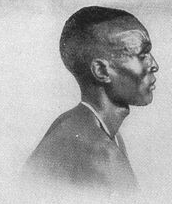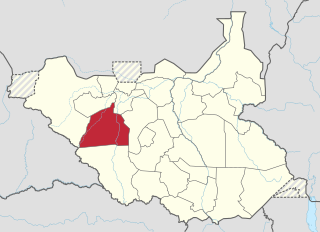
The White Nile is a river in Africa, the minor of the two main tributaries of the Nile, the larger being the Blue Nile. The name "White" comes from the clay sediment carried in the water that changes the water to a pale color.

Dave Eggers is an American writer, editor, and publisher. He is best known for his 2000 memoir, A Heartbreaking Work of Staggering Genius, which became a bestseller and was a finalist for the Pulitzer Prize for General Non-Fiction. Eggers is also the founder of several notable literary and philanthropic ventures, including the literary journal Timothy McSweeney's Quarterly Concern, the literacy project 826 Valencia, and the human rights nonprofit Voice of Witness. Additionally, he founded ScholarMatch, a program that connects donors with students needing funds for college tuition. His writing has appeared in numerous prestigious publications, including The New Yorker, Esquire, and The New York Times Magazine.

Western Bahr el Ghazal is a state in South Sudan. It has an area of 93,900 km2 (36,255 sq mi) and is the least populous state in South Sudan, according to the controversial Sudanese census conducted in 2008. It is part of the Bahr el Ghazal region. Its capital is Wau. The state shared international borders with Sudan to the north and the Central African Republic to the west. The portion now occupied by Raga County is the southern part of the historical region known as "Dar Fertit".

Northern Bahr el Ghazal(Arabic: ولاية شمال بحر الغزال) is a state in South Sudan. It has an area of 30,543 km2 and is part of the Bahr el Ghazal region. It borders East Darfur in Sudan to the north, Western Bahr el Ghazal to the west and south, and Warrap and the disputed region of Abyei to the east. Aweil is the capital of the state.

Warrap is one of the ten states in South Sudan, located in the Bahr el Ghazal region. The state became part of South Sudan after a successful secession from Sudan on 9 July 2011. Wanhalel, the place where first Jieng Customary Laws were initiated and hometown to prominent politician, Gen. Nhial Deng Nhial is located in Tonj South County of Warrap State The current governor is Kuol Muor Muor who replaced Manhiem Bol Malek in November, 2023.

The Bahr el Ghazal is a region of northwestern South Sudan. Its name came from the river Bahr el Ghazal. The name translates as "sea of gazelles" from Arabic.

The Dinka people are a Nilotic ethnic group native to South Sudan. The Dinka mostly live along the Nile, from Mangalla-Bor to Renk, in the region of Bahr el Ghazal, Upper Nile, and the Abyei Area of the Ngok Dinka in South Sudan.

The Lost Boys of Sudan refers to a group of over 20,000 boys of the Nuer and Dinka ethnic groups who were displaced or orphaned during the Second Sudanese Civil War (1987–2005). Two million were killed and others were severely affected by the conflict. The term was used by healthcare workers in the refugee camps and may have been derived from the children's story of Peter Pan by J. M. Barrie. The term was also extended to refer to children who fled the post-independence violence in South Sudan in 2011–2013.

Wau is a town, locally referred to as a city, in northwestern South Sudan on the western bank of Jur River It is the capital of Western Bahr el Ghazal region in South Sudan. It lies approximately 650 kilometres (400 mi) northwest of the capital, Juba. It is a diverse small urban center (town) and a trading hub. The city has been a municipality since 2012 and is governed by a mayor who the state governor usually appoints. The city comprises several neighborhoods including Nazareth, Hai Fahal, Sika Hadid, and Daraja.

What Is the What: The Autobiography of Valentino Achak Deng is a 2006 novel written by Dave Eggers. It is based on the life of Valentino Achak Deng, a Sudanese child refugee who immigrated to the United States under the Lost Boys of Sudan program. It was a finalist for the National Book Award.

Aweil is a city located in South Sudan. It is the capital of Northern Bahr el Ghazal state and the administrative centre of Aweil Center County. It is also a service centre for the surrounding villages. Refugees, war displaced returnees, nomadic cattle keepers and local families moving seasonally with their animals to source water give Aweil a mobile population.

Jur River County is a county in the Western Bahr el Ghazal state in the Bahr el Ghazal region of South Sudan, located in east and northeast parts of the state, Jur River County is divided into five payams (districts): Kangi Payam, Udoci, Marial Bai, Rocrocdong, and Kuajiena. Jur River County headquarters has been controversially relocated in 2012 by the state government to Nyin Akok Village on the eastern bank of the Jur River.
The Kuru River, or Chel River is a stream in the South Sudanese states of Western Bahr el Ghazal and Northern Bahr el Ghazal. It is a headwater of the Lol River.
University of Bahr El-Ghazal (UBG) is a university in South Sudan located in Wau, the capital of Western Bahr El Ghazal State.

Aweil State was a state in South Sudan that existed between 2 October 2015 and 22 February 2020. It was located in the Bahr el Ghazal region and it borders Gogrial to the east, Lol to the west, Aweil East to the north, and Wau to the south. Its capital and largest city was Aweil.

Aweil East also known as Abiem, was a state in South Sudan that existed between 2 October 2015 and 22 February 2020. It had an estimated population of 571,728 people and an area of 6,172.23 KM square. It was located in northern-western South Sudan. Its capital and largest city was Wanyjok. The state is located in the Bahr el Ghazal region and it bordered Twic State and Gogrial State to the east, Aweil State to the south, Lol State to the west, the disputed Abyei State region to the northeast, and Sudan to the north.

Wau State was a state in South Sudan that existed between 2 October 2015 and 22 February 2020. It was located in the Bahr el Ghazal region, and was part of the former state of Western Bahr el Ghazal. Wau State bordered Aweil State, Gbudwe State, Gogrial State, Lol State, and Tonj State.

Tonj State was a state in South Sudan that existed between 2 October 2015 and 22 February 2020. It was located in the Bahr el Ghazal region and it bordered Wau to the west, Gbudwe to the southwest, Gogrial to the northwest, Northern Liech to the northeast, Gok and Southern Liech to the east, and Western Lakes to the south and east.

Wau County is a county in Western Bahr el Ghazal state, in the Bahr el Ghazal region of South Sudan. Wau County was home to the state's capital, Wau. It is the most populous county in the state with over 232,910 people.
Areya is a town in Northern Bahr el Ghazal, South Sudan.

















